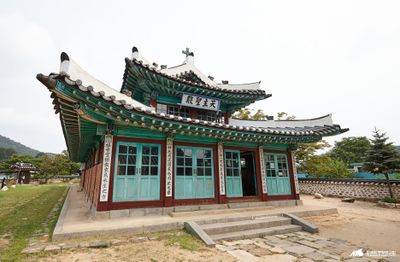GGHS 2019 Winter - Team 3
Religion in Ganghwa
목차
Team
| No. | Team Topic | Teacher | Role | Name (Korean) | No. of Students |
|---|---|---|---|---|---|
| 3 | Buddhism on Ganghwa (불교) |
Ritika | Leader | 박이○ | 8 |
| Vice-Leader | 유예○ | ||||
| 조수○ | |||||
| 김은○ | |||||
| 최축○ | |||||
| 이신○ | |||||
| 이승○ | |||||
| 김승○ |
Religion in Ganghwa
Religion
Here you can put whatever text and photo materials you would like relating to your topic. Feel free to include subheadings.
Anglicanism in Ganghwa
Anglicanism
Religious reformist Martin Luther and others influenced England in the 1520s, raising the movement for church reform in England. Even before the British Reformation of religion, a movement for church reform was being carried out. In particular, opposition to the Roman Catholic Church, which ruled England at that time, and the anti-clericalism movement were already taking place everywhere. Anglicanism was established against this background. The present great asset of the Anglicanism is the The Book of Common Prayer, that contains the Liturgy of the British Anglicanism. The Book of Common Prayer is still an important foundation for Anglican faith, worship, theology and spirituality, and is the basis of all the rituals of Anglican Church. Korea's Anglican Church of Korea uses a translated version of the book in Korean.[1]
The Background for establishment of Ganghwa Anglican Curch
The history of the Ganghwa Anglican Church began in 1889 when Mr. Koff was awarded the teaching position as the first Korean bishop. At that time, there was not a single believer in korea. It was in Ganghwa on June 13, 1896 where Koreans were first baptized. With such a background, the Anglican Church of Korea was the first to build a church in Ganghwa. Therefore, Ganghwa Anglican Cathedral history is old, and it is the oldest existing Hanok church building in Korea It was constructed with a bold combination of Western European style of Basilica and Oriental Buddhist temple style. The interior space of the church followed the pattern of the Basilica, while the exterior and outer space followed the pattern of Buddhist temples. A royal carpenter who participated in the construction of Gyeongbok Palace was in charge of the construction. The Anglican Church in Ganghwa not only shows the will of the early missionaries to naturalize themselves with the local culture but also provides a glimpse of the history of Korean Christianity. [2] [3]
Daejonggyo in Ganghwa
Daejonggyo
Daejonggyo is a religion that believes in Dangun, was created by Nacheol who was a religious activist at the Japanese occupation period. The Daesunggyo was founded because it has the driving force to be strengthen the nation’s foundation and revitalize its people during national crisis. The fundamental doctrines of Daejonggyo are the three laws (止, 調, 禁) and 三眞歸一 (性, 命, 精). Since it was founded during the Japanese colonial era, it has contributed more to the anti-Japanese independence movement than to its role as a religion. Daejonggyo is also the religion that created the National foundation day of Korea. [4]
Chamseongdan Altar in Ganghwa
Chamsungdan Altar is the place where a rituals, or jeecheon, are held to worship the sky and perform ancestral rites. Each Kingdom established an opportunity to solidify and unite its members through the Jechon event, and this tradition was continued during the Goryeo and Joseon periods. During the Goryeo and Joseon Dynasties, people held rituals in the state under the name of the king. There were regular and irregular rituals, regular rituals were held in spring and autumn. The purpose of the rite is believed to be to pray for the comfort and peace of the nation. Irregular rituals were held frequently in the event of natural disasters such as foreign invasions or droughts. Dangun Wanggeom, the founder of the Korean people, is known to have been built as an altar in short time of 51 years (BC2283). 인용 오류: <ref> 태그를 닫는 </ref> 태그가 없습니다
Map(s)
Network Graph(s)
- SAMPLE: VH2018_부석사reference.lst
- YOUR TEAM GRAPH: GGHS2019W_Team3.lst
References
- 인천광역시 문화유산 - 영문 해설문 포함 (한국학중앙연구원)

